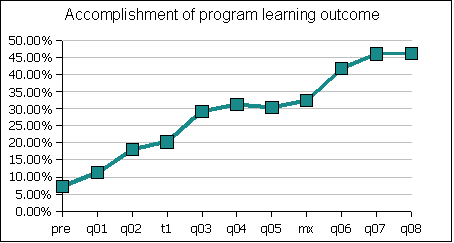MS 150 Statistics
Overall aggregate measure of the accomplishment of the course learning outcomes has leveled off again as the class moves into confidence interval calculations.

Individual measures of earlier concepts show continuing improvement. Basic statistical concepts such as being able to calculate the mean from raw data has gone from a 21% success rate among students on the pretest to 84% on a quiz given on 26 October. Data entry errors are the leading cause of miscalculating the mean, not an inability to determine how to calculate the mean.
| Description | pretest | test one | midterm | quiz 8 |
|---|
| level of measure | 5% | 80% | 60% | 91% |
| max | 81% | 92% | 100% | 98% |
| mean | 21% | 65% | 72% | 84% |
| median | 31% | 88% | 91% | 95% |
| min | 81% | 96% | 100% | 100% |
| mode | 10% | 80% | 98% | 100% |
| range | 24% | 84% | 96% | 82% |
| sample size | 12% | 61% | 89% | 89% |
| standard dev | 7% | 90% | 85% | 91% |
SC 130 Physical Science
As an experimental foray in data exploration, each item in the physical science item analysis was assigned an action verb and concept area. The action verb and concept area are forms of meta-data. The action verbs were then mapped against the concept area, with percentages being the percent of student success for that action verb-concept area pair. The data was then sorted, transposed, and sorted again to yield the following table.
| action | precision | statistical | units | wave | average | motion | weather | optics | earth | measurement | heat |
|---|
| determine | 26% | 39% | 33% | | 31% | | | | | | |
| predict | | | | | 34% | 33% | | | | 37% | |
| identify | | 35% | | | 35% | | | | | | |
| calculate | | 8% | | 83% | 35% | 36% | | | | 43% | |
| overall | 26% | 31% | 33% | 36% | 41% | 43% | 46% | 50% | 52% | 53% | 67% |
| sketch | | | | 40% | 44% | 55% | 43% | | | | |
| interpret | | 49% | | | 49% | | | | | | |
| reason | | | | | 55% | 48% | | | 57% | 69% | 50% |
| describe | | | | | 56% | | 47% | | | | 84% |
| recall | | | | 7% | 58% | 97% | 50% | 50% | 41% | 58% | 73% |
| define | | | | | 86% | 86% | | | | | |
The action verbs can be read "Students were able to..." and the concept areas can be taken as topic areas in physical science. The word "reason" is used in the sense "to reason" as in "to think, to explain" rather than as in "to give a reason." The term "statistical" refers to questions which asked for what is essentially a statistical result such as a mean value, a slope, or an intercept. "Units" refers to inclusion of correct units in answers. Students must get the correct answer before having the correct units is counted. Thus the 33% value represents correctly answered problems with correct units. These problems are usually calculation problems.
Students do well on basic recall and define questions, performing less well on mathematical calculations, and determining a result.
On the most recent quiz I retreated from demanding that students get the significant digits correct (precision). Students have yet to master getting calculations correct, precision is an additional layer of complexity which confounds the students. Until such time as more students can reliably calculate a correct result, worrying about precision is superfluous.
